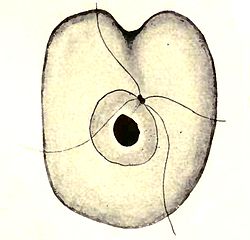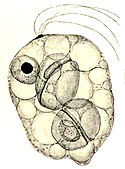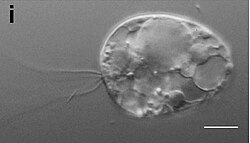Collodictyon meets Pandorina
Größe:
1085 x 838 Pixel (241761 Bytes)
Beschreibung:
Collodictyon meets
Pandorina and loses out. Escape of
Pandorina and subsequent dissolution of
Collodictyon due to drying. Diagrammatic. × 750. 1.
Pandorina within food vacuole. 2.
Pandorina swimming away; ruptured surface of
Collodictyon. 3, 4. Apparent healing of torn surface. 5. Fusion of ends of protoplasmic processes, enclosing water vacuole; of frequent occurrence. 6-8. Resorption of protoplasmic processes. 8, 9. Flattening of body; formation of pathological vacuoles indicative of dissolution. 10. Bursting of vacuole at anterior region of sulcus. 11. Further dissolution, rupturing posteriad along the sulcus. 12. Nucleus and blepharoplast freed by dissolution, a. Nucleus; nuclear membrane persisted for two minutes. b. Rupture of nuclear membrane, c. Karyosome; persisted for thirty minutes; finally broke up into small granules, d. Blepharoplast; basal granules surrounded by archoplasm, flagella still moving, e. Rupturing of archoplasmic mass; flagella cease beating.
Weitere Informationen zur Lizenz des Bildes finden Sie hier. Letzte Aktualisierung: Wed, 05 Mar 2025 10:46:22 GMT
Relevante Bilder
Relevante Artikel
Collodictyon
Collodictyon ist eine Gattung einzelliger, allesfressender, quadriflagellater Eukaryonten aus der Familie der Collodictyoniden (Collodictyonidae) – auch Diphylleiden (Diphylleidae) genannt.
Aufgrund ihrer Vielzahl verschiedener zellulärer Komponenten sind die Collodictyoniden von den meisten anderen Eukaryonten-Familien verschieden und gehören zu keinem bekannten Phylum oder Reich derselben.
Neuere Forschungen stellen sie zusammen mit der Ordnung der Rigifiliden (Rigifilida) und den monotypischen Mantamonadidae in eine neue „Supergruppe“ mit dem Namen „CRuMs“.
Xavier Grau-Bové et al. (2022) sehen diese Supergruppe basal im Stammbaum der Amoebozoa.
.. weiterlesen













